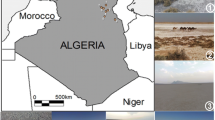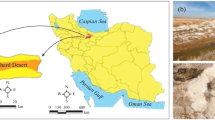Abstract
A total of 17 species from 43 isolates were obtained through serial dilutions of soil samples isolated from one of the man-made solar salterns located in Ban Laem district of Phetchaburi province, Thailand. Soil analysis of the sample revealed high salinity and moisture content, slight alkalinity and low amounts of nitrogen, total organic carbon and organic matter in the habitat. Morphological analysis was performed on all isolates, and molecular identification and phylogenetic analysis were carried out only on the halophilic fungi isolated. Six halophilic fungi, belonging to four species, were identified among the isolates, including five strains of Aspergillus genus [Aspergillus flavus, A. gracilis, A. penicillioides (2 strains) and A. restrictus]. One species was found to be a yeast, namely, Sterigmatomyces halophilus, which was the most frequent isolate found among the halophilic fungi. All other isolates were halotolerant fungi. Characterization of the halophilic fungal isolates showed that they were best adapted to conditions of 10–15 % NaCl (w/v), slight alkalinity (pH 7.0–7.5) and a temperature range of 30–35 °C.







Similar content being viewed by others
References
Astoreca A, Magnoli C, Ramirez ML, Combina M, Dalcero A (2007) Water activity and temperature effects on growth of A. niger, A. awamori and A. carbonarius isolated from different substrates in Argentina. Int J Food Microbiol 119:314–318
Bremner JM, Mulvaney CS (1982) Nitrogen—total. In: Page AL et al (eds) Agronomy monograph 9, part 2, 2nd edn. American Society of Agronomy, Madison, pp 595–624
Bruce RC, Rayment GE (1982) Analytical methods and interpretations used by the agricultural chemistry branch for soil and land use surveys. Bulletin QB82004, No 5. Queensland Department of Primary Industries, Indooroopilly
Buresh RJ, Austin ER, Craswell ET (1982) Analytical methods in –15 research. Fert Res 3:37–62
Butinar L, Zalar P, Frisvad JC, Gunde-Cimerman N (2005) The genus Eurotium—members of indigenous fungal community in hypersaline waters of salterns. FEMS Microbiol Ecol 51:155–166
Cantrell SA, Casillas-Martinez L, Molina M (2006) Characterization of fungi from hypersaline environments of solar salterns using morphological and molecular techniques. Mycol Res 110:962–970
Carmichael JW, Kendrick WB, Conners IL, Sigler L (1980) Genera of hyphomycetes. University of Alberta Press, Calgary
El-Kassas HY, Khairy HM (2009) A trial for biological control of a pathogenic fungus (Fusarium solani) by some marine microorganisms. Am-Euras J Agric Environ Sci 5:434–440
Ellis MB (1971) Dematiaceous hyphomycetes. Commonwealth Mycological Institute, Kew
El-Said AHM, Saleem A (2008) Ecological and physiological studies on soil fungi at western region, Libya. Mycobiology 36:1–9
Ghassemi F, Jakeman AJ, Nix HA (1995) Salanisation of land and water resources. CAB Int, Wallingford
Gostinčar C, Lenassi M, Gunde-Cimerman N, Plemenitaš A (2011) Fungal adaptation to extremely high salt concentrations. Adv Appl Microbiol 77:71–96
Gunde-Cimerman N, Zalar P, de Hoog S, Plemenitaš A (2000) Hypersaline waters in salterns: natural ecological niches for halophilic black yeasts. FEMS Microbiol Ecol 32:235–240
Gunde-Cimerman N, Zalar P, Petrovič U, Turk M, Kogej T, de Hoog GS, Plemenitaš A (2004) Fungi in the salterns. In: Ventosa A (ed) Halophilic microorganisms. Springer, Heidelberg, pp 103–113
Gunde-Cimerman N, Ramos J, Plemenitaš A (2009) Halotolerant and halophilic fungi. Mycol Res 113:1231–1241
Hach Company (1992) Soil and irrigation water interpretation manual. Hach Company, Loveland
Hazelton PA, Murphy BW (2007) Interpreting soil test results: what do all the numbers mean? 2nd edn. CSIRO Publishing, Collingwood
Javor BJ (2002) Industrial microbiology of solar salt production. J Ind Microbiol Biotech 28:42–47
Klich MA, Pitt JI (1988) A laboratory guide to the common Aspergillus species and their teleomorphs. Commonwealth Scientific and Industrial Research Organization, Division of food processing, North Ryde
Kushner DJ (1993) Growth and nutrition of halophilic bacteria. In: Vreeland RH, Hochstein LI (eds) The biology of halophilic bacteria. CRC Press, Boca Raton, pp 87–89
Madigan MT, Martinko JM, Parker J (1997) Brock: Biology of microorganisms, 8th edn. Prentice-Hall, Upper Saddle River
Oren A (1999) Bioenergetic aspects of halophilism. Microbiol Mol Biol Rev 63:334–348
Oren A (2002) Diversity of halophilic microorganisms: environments, phylogeny, physiology, and applications. J Ind Microbiol Biotech 28:56–63
Phillips MW, Gordon GLR (1989) Growth characteristics on cellobiose of three different anaerobic fungi isolated from the ovine rumen. Appl Environ Microbiol 55:1695–1702
Plemenitaš A, Vaupotič T, Lenassi M, Kogej T, Gunde-Cimerman N (2008) Adaptation of extremely halotolerant black yeast Hortaea werneckii to increased osmolarity: a molecular perspective at a glance. Stud Mycol 61:67–75
Reed RH (1986) Halotolerant and halophilic microbes. In: Herbert RA, Codd GA (eds) Microbes in extreme environments. Academic Press, London, pp 55–82
Subramanian CV (1976) Hyphomycetes. Indian Council of Agricultural Research, New Delhi
Sutton LM, Starzyk MJ (1972) Procedure and analysis of a useful method in determining mycelial dry weights from agar plates. Appl Microbiol 24:1011–1012
Tamura K, Dudley J, Nei M, Kumar S (2007) MEGA4: molecular evolutionary genetics analysis (MEGA) software version 4.0. Mol Biol Evol 24:1596–1599
Thompson JD, Gibson TJ, Plewniak F, Jeanmougin F, Higgins DG (1997) The Clustal X windows interface: flexible strategies for multiple sequence alignment aided by quality analysis tools. Nucleic Acids Res 24:4876–4882
Tresner HD, Hayes AJ (1971) Sodium chloride tolerance of terrestrial fungi. Appl Microbiol 22:210–213
Ventosa A, Nieto JJ, Oren A (1998) Biology of moderately halophilic aerobic bacteria. Microbiol Mol Biol Rev 62:504–544
Walkley A (1947) A critical examination of a rapid method for determination of organic carbon in soils - Effect of variations in digestion conditions and of inorganic soil constituents. Soil Sci 63:251–257
Zalar P, de Hoog GS, Schroers H-J, Frank JM, Gunde-Cimerman N (2005) Taxonomy and phylogeny of the xerophilic genus Wallemia (Wallemiomycetes and Wallemiales, cl. et ord. nov.). Antonie Van Leeuwenhoek 87:311–328
Acknowledgment
We thank all of the people who helped us in this study, especially the lab staff of Fungal Diversity Lab KMUTT, Thailand.
Author information
Authors and Affiliations
Corresponding author
Rights and permissions
About this article
Cite this article
Ali, I., Kanhayuwa, L., Rachdawong, S. et al. Identification, phylogenetic analysis and characterization of obligate halophilic fungi isolated from a man-made solar saltern in Phetchaburi province, Thailand. Ann Microbiol 63, 887–895 (2013). https://doi.org/10.1007/s13213-012-0540-6
Received:
Accepted:
Published:
Issue Date:
DOI: https://doi.org/10.1007/s13213-012-0540-6




